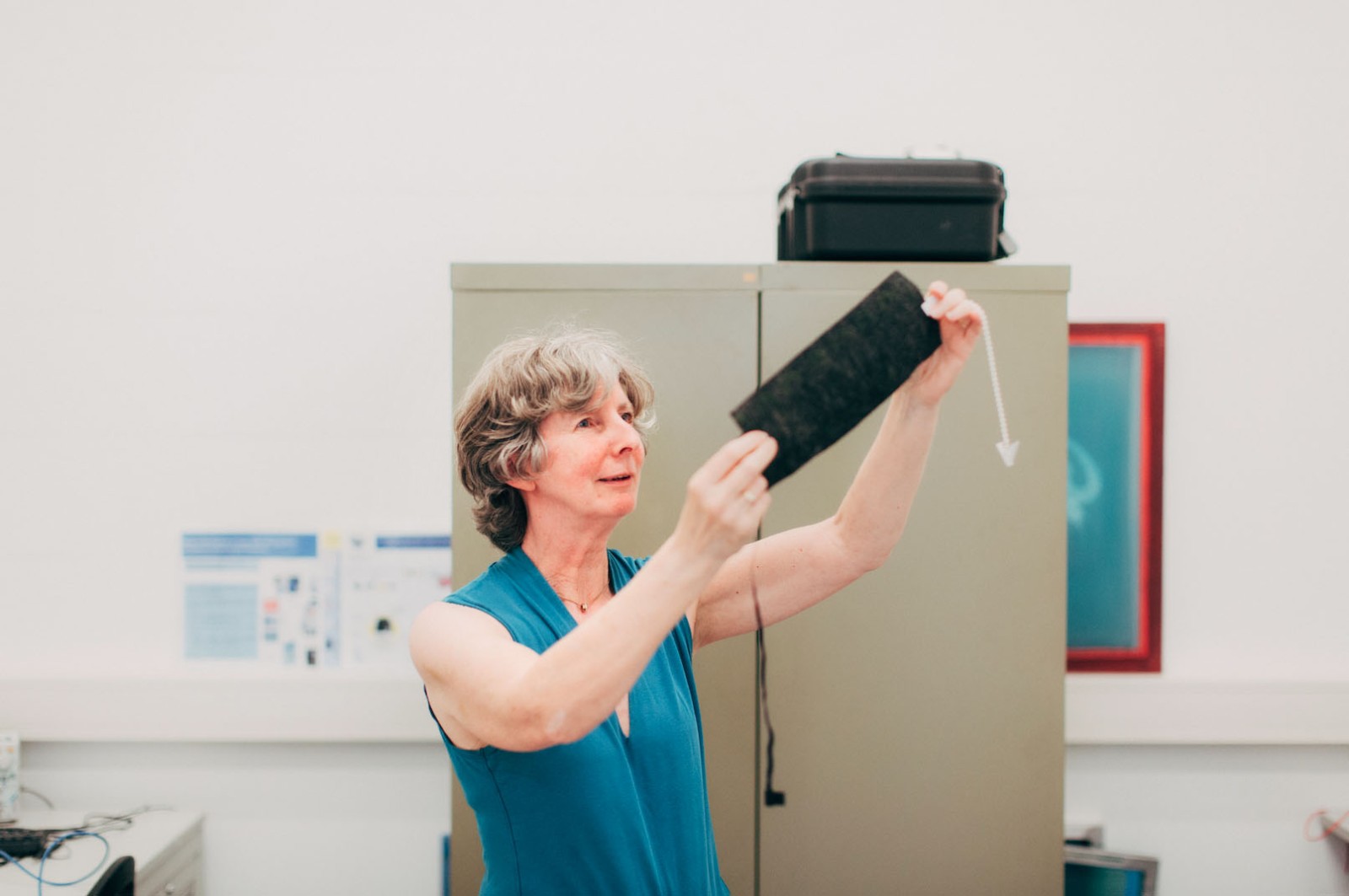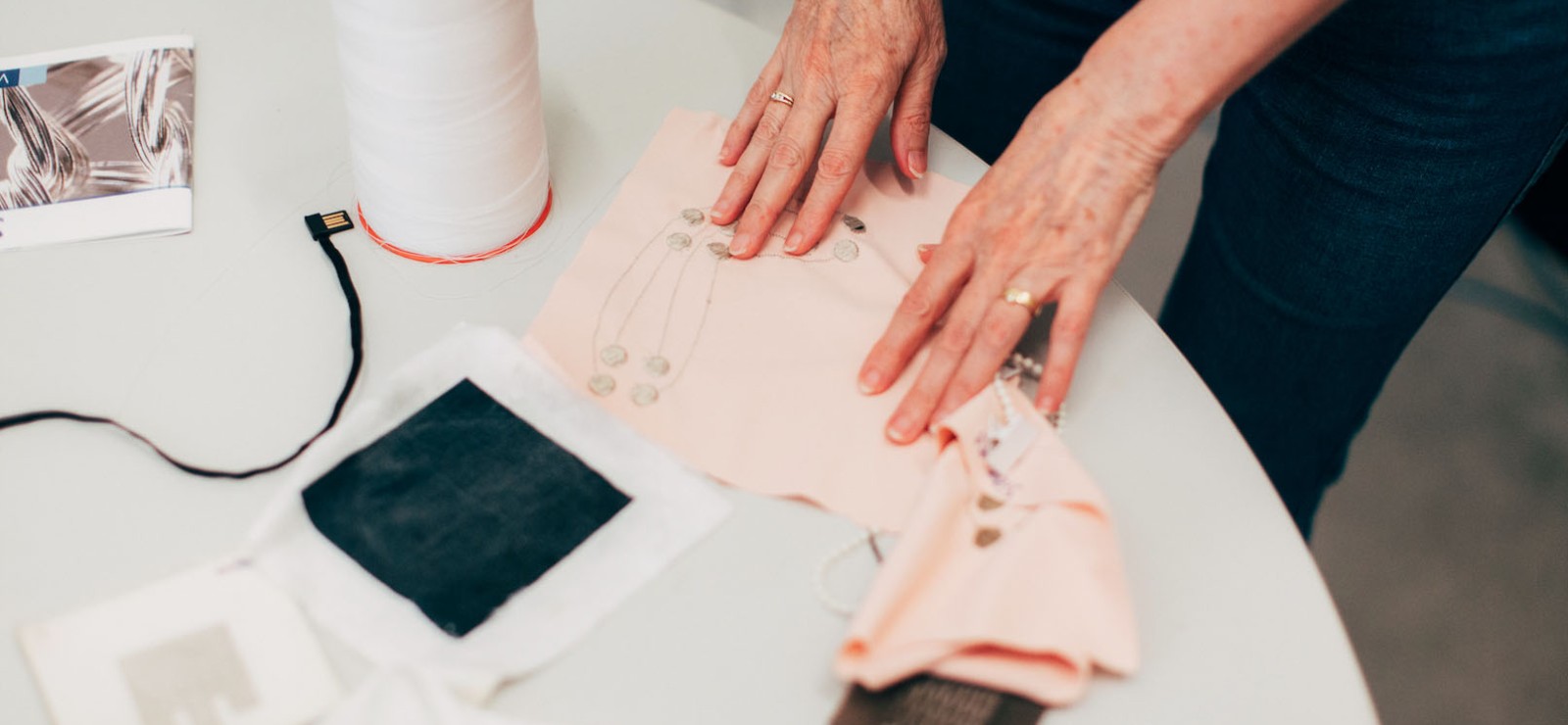Will we soon be wearing smart textiles that can adapt to the heat? Professor Lieva Van Langenhove of the Department of Materials, Textiles and Chemical Process Engineering explains how that could work.
A cooling suit that keeps us fresh in tropical temperatures: it is one of the research projects of Professor Lieva Van Langenhove’s team. “We’ve developed a fabric that absorbs heat on one side and radiates it on the other. In doing so, we are laying the foundation for a garment that will keep us fresh during hot summer days.”
A game of electrons
“The basic technology for the cooling suit is based on the peltier-effect,” explains Lieva. This effect is named after the French physicist Peltier. He discovered that you can remove heat or generate it if you let electricity flow between two conductors.
“We incorporate very thin carbon fibers in the fabric, on which we deposit a nickel layer in the appropriate places. Through these carbon fibers we pass a current.”
Carbon will behave as a neutral (semi-)conductor, nickel as a positive one. Because electrons prefer to go to positive and better conducting material, they accelerate toward the nickel layer. The energy they need for this, they get from the heat in the environment. This creates a cooling effect. The reverse also happens: if they go from the nickel layer to the carbon fibers, they slow down and radiate heat. Lieva: “As a result, one side is warm, and the other side is cool.”

Smart versus functional textiles
The cooling suit interacts with the environment, making it an example of smart textiles. “We distinguish two types: functional and smart textiles,” explains Lieva. “Functional textile can respond to the environment with certain properties - for example, the fabric is moisture-resistant or air-permeable, thus providing as much comfort as possible. But it is not changeable. A characteristic of smart textiles is that they detect stimuli from the environment, such as heat, and react to them in an appropriate manner.”
For the time being, during hot summer days you can still manage without a cooling suit. “The basis is there,” assures Lieva. “But some research work is still needed. For example, we still need to find a way to dissipate the heat.” It is in any case Lieva’s ambition is to bring the product to the market in the future.
What clothing can already help against the heat?
In the meantime, we can already adapt our clothing a little. Lieva: “On the one hand you have the materials that absorb moisture, such as cotton or viscose. That works well, until they are saturated. Then they feel wet, which is not comfortable. So if you sweat a lot, it’s better not to wear that.”
“In addition, there are fabrics with an uneven instead of smooth fiber, such as CoolMax, a high-tech synthetic polyester fiber. This material ensures that moisture evaporates faster, which has a cooling effect. Then again, some fabrics, like polypropylene, wick moisture away quickly so that it does not cool down.”
The right fit
It’s not only the material, but also a proper fit that can have a big impact. Although that’s not a simple matter. “A layer of air between the fabric and your skin provides extra insulation. Close-fitting clothing is then in principle better. On the other hand, loose clothes provide more ventilation when you move. That said, there is no debate about one thing: during hot days, black clothing absorbs more heat. Light clothing reflects it.”
So, what’s best to wear during hot summer days depends on a lot of factors. But who knows: maybe soon we won’t have to think about that anymore and we’ll be wearing clothing that adapts itself.

Lieva Van Langenhove is a professor in the Department of Materials, Textiles and Chemical Process Engineering (Faculty of Engineering and Architecture). When her daughter was admitted to hospital in 1999, she developed a blanket with sensors that protects babies against crib death. For now, that same technology is used mainly in sports applications, such as in Adidas’ miCoach. Since then, she has been specializing in smart textiles.
Read also
Understanding the impact of climate change? Measure, measure and measure again!
“Climate change is a global problem. But if you really want to know its impact, you have to have local data.” So say meteorologist Steven Caluwaerts and bioengineer Pieter De Frenne. They both do research on microclimates, albeit with a different starting point. “Actually, we are very complementary. We should meet more often!”
Climate tower in Congo fills a big gap in our knowledge
Deep in the Congolese rainforest stands a tower 57 metres high that is helping in the fight against climate change. Since October 2020, the Ghent University climate tower has been measuring both the amount of CO2 captured and stored by the tropical rainforest and the levels of water exchange between the forest and the atmosphere.
Student Helena participated in world's largest climate summit
Helena Van Tichelen was in secondary school when the school strikes and marches around climate change erupted. Years later, she has not lost the commitment she picked up then. In mid-November, she put aside the lessons and courses of her third bachelor in bioengineering to travel to Egypt for the largest climate conference in the world: COP27.
Ghent University developing the climate-adaptive forest of the future
The last years’ drought has caused stress in trees. Some have stopped growing; others have shed their foliage. Sometimes entire forests have perished. The bioengineers at the Department of Environment (Faculty of Bioscience Engineering) are crossing national borders to try to find out the causes of the problems effecting trees globally and working on a type of forest that can cope with climate change.




